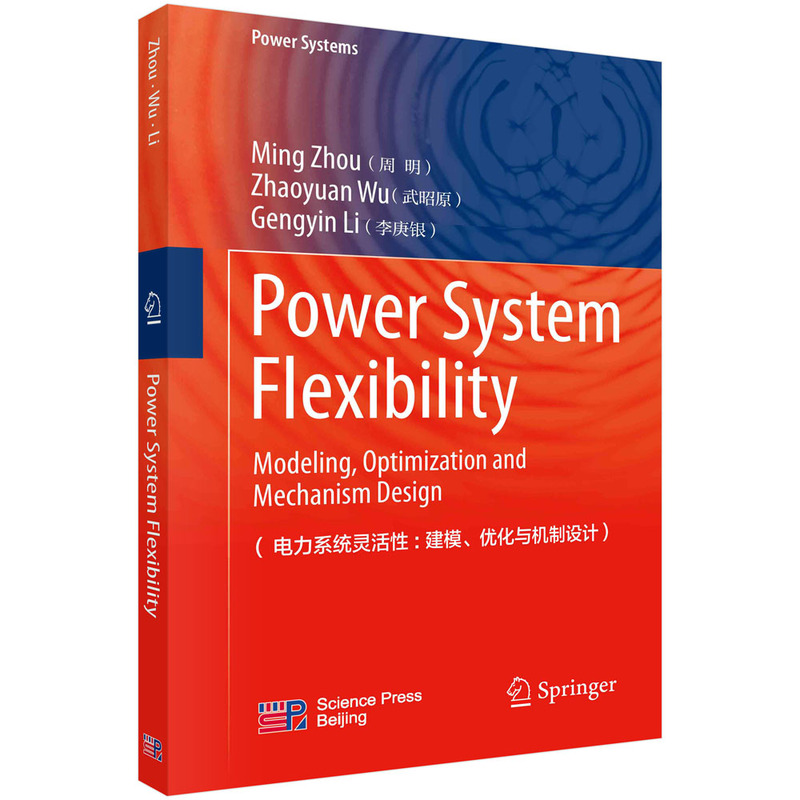
包邮电力系统灵活性:建模,优化与机制设计(英文版)
1星价
¥203.8
(7.9折)
2星价¥203.8
定价¥258.0

暂无评论
图文详情
- ISBN:9787030754493
- 装帧:平装胶订
- 册数:暂无
- 重量:暂无
- 开本:B5
- 页数:284
- 出版时间:2023-06-01
- 条形码:9787030754493 ; 978-7-03-075449-3
本书特色
本著作旨在系统探索电力系统灵活性的建模、优化方法和机制设计理论,为构建含高比例可再生能源的电力系统灵活高效运营提供理论支撑。
内容简介
含高比例可再生能源的电力系统,波动性电源出力的随机性和不确定性对系统安全可靠运行带来了新挑战,提出了电力系统灵活性的新需求。本著作旨在系统探索电力系统灵活性的建模、优化方法和机制设计理论,为构建含高比例可再生能源的电力系统灵活高效运营提供理论支撑。本著作首先给出了适用于高比例可再生能源电力系统的灵活性内涵和定义,并根据现有工程经验和理论研究成果,分析了不同时空尺度下高比例可再生能源的灵活性需求,并从灵活性量化建模方法、灵活性约束下的系统优化运行以及提升运行灵活性的机制设计三方面归纳总结了当前电力系统灵活性研究难点与挑战。据此,本著作后续章节包括:灵活性资源的建模、数据驱动的大规模灵活性资源等效模型、基于灵活性的优化调度方法、考虑灵活性需求的互联系统协同优化方法、提升系统灵活性的市场机制设计方法等关键基本方法和理论。期待本著作能够为电气工程领域的读者拓宽新能源电力系统的分析理论和方法。
目录
1 Introduction
1.1 Why Is Flexibility Necessary for the Power System
1.2 Overview of Power System Flexibility
1.2.1 History and Development
1.2.2 Taxonomy-Power System Flexibility Sources
1.2.3 Power System Flexibility Analysis
1.3 Market Solutions
1.4 Summary
References
2 Power System Flexibility Modelling
2.1 Introduction
2.2 Power System Flexibility Resource Classification
2.2.1 Demand Side Flexibility Resources
2.2.2 Power Supply Side Flexibility Resources
2.2.3 Grid Side Flexibility Resources
2.3 Flexible Power Supply Resources: Analysis and Modelling
2.3.1 Technical Characteristics of Flexible Power Supply Resources
2.3.2 Economic Characteristics of Power Supply Resources Flexibility
2.4 Demand Side Flexibility Model
2.4.1 Interruptible Load
2.4.2 Adjustable Load
2.4.3 Shiftable Load
2.5 Power Grid Flexible Regulation Technologies
2.5.1 Voltage Source Converter (VSC) Based Multiple-Terminal DC Transmission
2.5.2 AC Grid Flexible Topology Control
2.6 Conclusions
References
3 Flexibility-Based Economic Dispatch
3.1 Introduction
3.2 Quantifying Accommodated Domain of Wind Power for Flexible Look-Ahead Unit Commitment
3.2.1 Formulation of ADWP
3.2.2 Flexible Look-Ahead Unit Commitment Models
3.3 Flexibility Based Day-Ahead Generation-Reserve Bilevel Decision Model
3.3.1 Day-Ahead Unit Commitment Model Considering Flexibility Constraint
3.3.2 Flexibility Based Reserve Decision Method
3.4 An Endogenous Approach to Quantifying the Wind Power Reserve
3.4.1 Dynamic S&NCED Model with AARO
3.4.2 Two-Stage Solution Method Based on the Benders Decomposition
3.5 Case Studies
3.5.1 Case Studies of the Flexible Look-Ahead Unit Commitment
3.5.2 Case Studies of the Day-Ahead Generation-Reserve Bilevel Decision Model
3.5.3 Case Studies of the Endogenous Approach to Quantifying the Wind Power Reserve
3.6 Conclusion
References
4 Distributed Dispatch Approach in AC/DC Hybrid Systems
4.1 Introduction
4.2 Distributed Dispatch Approach in Bulk AC/DC Hybrid Systems
4.2.1 Distributed Scheduling Framework for Bulk AC/DC Hybrid Transmission Systems
4.2.2 Improved ATC-Based Distributed SCUC for a Bulk AC/DC Hybrid System
4.2.3 Solution Procedure
4.3 Distributed Dispatch Approach in the VSC-MTDC Meshed AC/DC Hybrid Systems
4.3.1 Hierarchy of VSC-MTDC Meshed AC/DC Grid
4.3.2 Hierarchical and Robust Scheduling Formulation
4.3.3 Solution Methodology
4.4 Case Studies
4.4.1 Distributed Dispatch Approach in Bulk AC/DC Hybrid Systems
4.4.2 Distributed Dispatch Approach in VSC-MTDC Meshed AC/DC Hybrid Systems
4.5 Conclusion
References
5 Exploring Operational Flexibility of AC/DC Power Grids
5.1 Introduction
5.2 Improving Flexible Operation of MTDC Hybrid Networks by VSC Power Regulation
5.2.1 Problem Description
5.2.2 Flexible Operation Mechanism and Model
5.2.3 Flexible Operation Improvement Mode for VSC Station
5.3 Exploiting the Operational Flexibility of Wind Integrated Hybrid AC/DC Power Systems
5.3.1 SCED Model with TS for Hybrid AC/DC Grid
5.3.2 Two-Stage RO Based on C&CG
5.4 Case Studies
5.4.1 Verify of Power Margin Tracking Droop Regulation (PMT) Mode
5.4.2 Exploring Operational Flexibility of AC/DC Power Networks Using TS
5.5 Conclusion
References
6 Demand Side Flexibility
6.1 Introduction
6.2 Residential Load Demand Response Model
6.3 Price-Based Demand Response Model
6.3.1 Energy Management Model of the ITCA
6.3.2 Flexibility of ITCAs
6.3.3 ITCAs' Flexibility Under TOU Power Price
6.3.4 Unit Scheduling Model Considering the Flexibility of ITCAs
6.4 Integrated Energy System Demand Response Model
6.4.1 Typical Topology
6.4.2 Integrated Demand Response Model
6.4.3 Two-Stage Stochastic Chance-Constrained Programming Model
6.5 Case Studies
6.5.1 Residential Load Demand Response
6.5.2 Price-Based Demand Response Model
6.5.3 Integrated Energy System Demand Response
6.6 Conclusion
References
7 Large-Scale Distributed Flexible Resources Aggregation
7.1 Introduction
7.2 Large Scale Interruptible and Shiftable Load Aggregation
7.2.1 Equivalent Aggregated Model for Large-Scale Interruptible and Shiftable Loads
7.2.2 Equivalent Model for a Single Group
7.2.3 Scheduling with Equivalent Aggregated Model
7.3 Large Scale EV Aggregation
7.3.1 Market Framework
7.3.2 Aggregate Model of Electric Vehicle Fleets
7.3.3 Model of Optimal Bidding Strategy of Microgrid
7.4 Case Study
7.4.1 Large Scale Interruptible and Shiftable Load Aggregation
7.4.2 Large Scale Distributed Energy Storage Aggregation
7.5 Conclusion
References
8 Market Mechanism Design for Enhancing the Flexibility of Power Systems
8.1 Introduction
8.2 The Framework of Balancing Market
8.2.1 The Framework of Balancing Market
8.2.2 Key Design Elements in Imbalance Settlement
8.3 System Model
8.3.1 Balancing Market Clearing Optimization Model Embedded with the Offering Strategy of Wind Power Producers
8.3.2 Offering Strategy of the Wind Power Producer
8.3.3 Objective Function and Constraints
8.3.4 Solution Method
8.3.5 ABM Method
8.3.6 The MCDA Evaluation
8.4 Case Studies
8.4.1 Analysis of Wind Power Supplier's Strategic Offering
8.4.2 Analysis of Strategic Interaction Behavior of Market Players
8.5 Conclusion
References
展开全部
本类五星书
浏览历史
本类畅销
-

污水处理工程工艺设计从入门到精通
¥70.3¥89.0 -

发电厂电气部分
¥34.6¥58.0 -

植物进化的故事
¥19.9¥59.0 -

赶往火星:红色星球定居计划
¥44.5¥58.0 -

果脯蜜饯加工技术
¥4.5¥12.0 -

数控车工
¥5.9¥11.5 -

数据驱动的剩余寿命预测与维护决策技术
¥63.4¥79.0 -

手术机器人导航与控制
¥127.4¥169.8 -

射频干扰袖珍手册
¥18.4¥29.0 -

汽车车身构造与修复
¥30.7¥45.0 -

群目标分辨雷达初速测量技术
¥42.4¥69.0 -

秸秆挤压膨化技术及膨化腔流道仿真研究
¥40.6¥55.0 -

NVH前沿科技与工程应用
¥109.7¥159.0 -

电力系统分析
¥23.8¥38.0 -

继电保护原理
¥30.4¥49.0 -

不确定条件下装备剩余寿命预测方法及应用
¥60.4¥99.0 -

船舶分段装配
¥58.6¥80.0 -

基于深度学习的复杂退化系统剩余寿命智能预测技术
¥54.4¥89.0 -

火星探测器轨道动力学与控制
¥59.8¥98.0 -

美军联合作战弹药保障
¥35.8¥58.0











